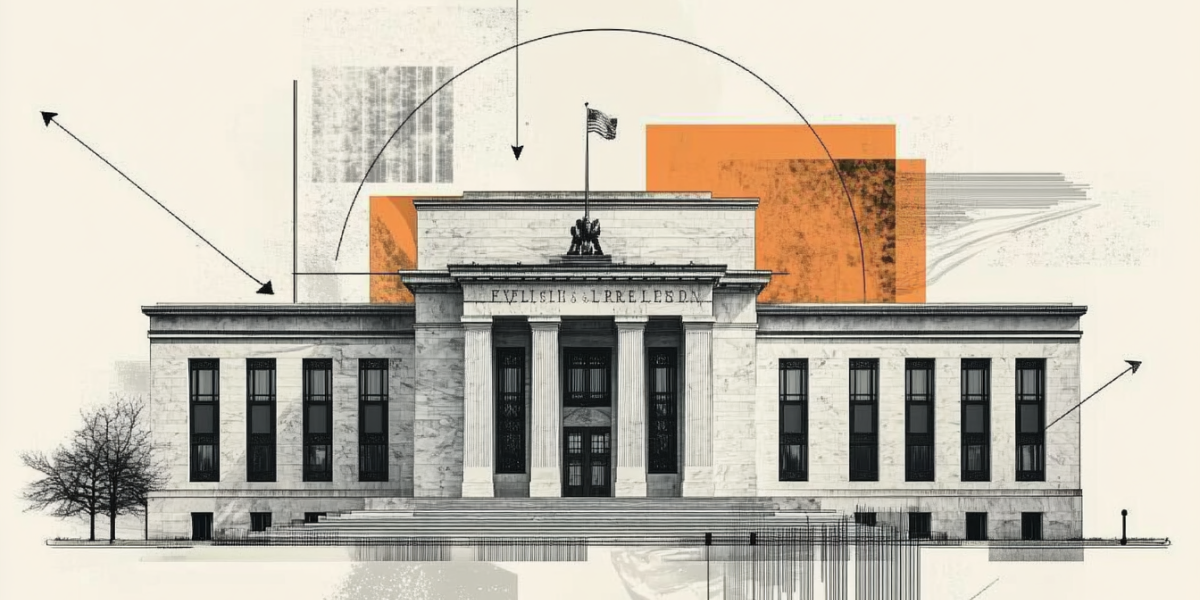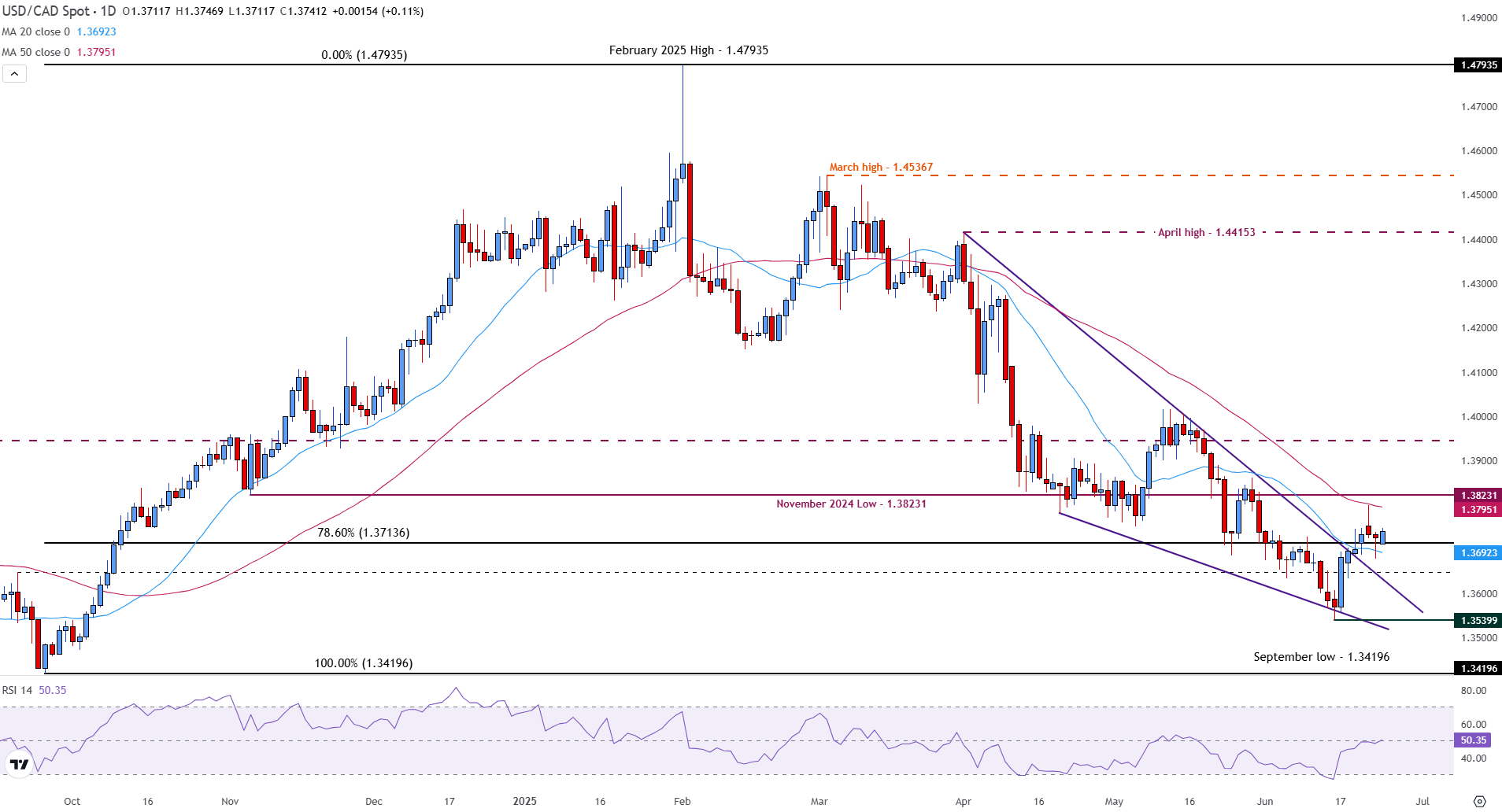Created
: 2025.06.25













![]() 2025.06.25 22:49
2025.06.25 22:49
The Canadian Dollar (CAD) is softening against the US Dollar (USD) on Wednesday as the currency pair attempts to break free from a consolidation phase.
With USD/CAD trading near 1.3750 at the time of writing, the release of US New Home Sales data for May and Federal Reserve (Fed) Jerome Powell's testimony are in focus.
The US Census Bureau will release its latest figures on New Home Sales at 14:00 GMT, which reflect the number of single-family homes sold, regardless of their stage in the construction process. Expectations are for 690,000 units were sold in May, with market participants also paying attention to the monthly percentage change.
With New Home Sales in April rising sharply by 743,000 ahead of the implementation of tariffs, the May report may provide a clearer picture of how the construction and housing industry is performing under current conditions.
At the same time, Fed Chair Jerome Powell will testify before the US Senate Committee on Banking, Housing, and Urban Affairs. This is the second and final day of the semiannual Monetary Report hearing, where Powell will continue to be questioned on inflation, interest rates, and the overall health of the US economy.
This hearing is particularly important, as it may provide valuable insights into the Federal Reserve's future plans for interest rates.
Investors will carefully analyze Powell's remarks for any signals about inflation trends, economic growth, and how the Fed may adjust interest rates in the coming months.
The USD/CAD pair is currently consolidating around the 1.3740 level, slightly above the key 78.6% Fibonacci retracement of the September-February rise at 1.3713.
Recent price action indicates a breakout from a descending wedge pattern, suggesting a potential shift in momentum. However, the pair is facing strong resistance near the 50-day Simple Moving Average (SMA) at 1.3795 and the November 2024 low at 1.3823. These levels will be critical in determining whether the pair can sustain a bullish reversal.

Meanwhile, the Relative Strength Index (RSI) sits near 50 on the daily chart, indicating neutral momentum and a lack of clear direction.
A decisive move above the resistance zone could open the path toward the April high at 1.4415, while a failure to hold current support at the key 78.6% Fibonacci retracement might lead the pair back toward the June 16 low at 1.3539 or even the September low at 1.3419.
The US Dollar (USD) is the official currency of the United States of America, and the 'de facto' currency of a significant number of other countries where it is found in circulation alongside local notes. It is the most heavily traded currency in the world, accounting for over 88% of all global foreign exchange turnover, or an average of $6.6 trillion in transactions per day, according to data from 2022. Following the second world war, the USD took over from the British Pound as the world's reserve currency. For most of its history, the US Dollar was backed by Gold, until the Bretton Woods Agreement in 1971 when the Gold Standard went away.
The most important single factor impacting on the value of the US Dollar is monetary policy, which is shaped by the Federal Reserve (Fed). The Fed has two mandates: to achieve price stability (control inflation) and foster full employment. Its primary tool to achieve these two goals is by adjusting interest rates. When prices are rising too quickly and inflation is above the Fed's 2% target, the Fed will raise rates, which helps the USD value. When inflation falls below 2% or the Unemployment Rate is too high, the Fed may lower interest rates, which weighs on the Greenback.
In extreme situations, the Federal Reserve can also print more Dollars and enact quantitative easing (QE). QE is the process by which the Fed substantially increases the flow of credit in a stuck financial system. It is a non-standard policy measure used when credit has dried up because banks will not lend to each other (out of the fear of counterparty default). It is a last resort when simply lowering interest rates is unlikely to achieve the necessary result. It was the Fed's weapon of choice to combat the credit crunch that occurred during the Great Financial Crisis in 2008. It involves the Fed printing more Dollars and using them to buy US government bonds predominantly from financial institutions. QE usually leads to a weaker US Dollar.
Quantitative tightening (QT) is the reverse process whereby the Federal Reserve stops buying bonds from financial institutions and does not reinvest the principal from the bonds it holds maturing in new purchases. It is usually positive for the US Dollar.
![]()
Created
: 2025.06.25
![]()
Last updated
: 2025.06.25

FXStreet is a forex information website, delivering market analysis and news articles 24/7.
It features a number of articles contributed by well-known analysts, in addition to the ones by its editorial team.
Founded in 2000 by Francesc Riverola, a Spanish economist, it has grown to become a world-renowned information website.
We hope you find this article useful. Any comments or suggestions will be greatly appreciated.
We are also looking for writers with extensive experience in forex and crypto to join us.
please contact us at [email protected].
Disclaimer:
All information and content provided on this website is provided for informational purposes only and is not intended to solicit any investment. Although all efforts are made in order to ensure that the information is correct, no guarantee is provided for the accuracy of any content on this website. Any decision made shall be the responsibility of the investor and Myforex does not take any responsibility whatsoever regarding the use of any information provided herein.
The content provided on this website belongs to Myforex and, where stated, the relevant licensors. All rights are reserved by Myforex and the relevant licensors, and no content of this website, whether in full or in part, shall be copied or displayed elsewhere without the explicit written permission of the relevant copyright holder. If you wish to use any part of the content provided on this website, please ensure that you contact Myforex.
Myforex uses cookies to improve the convenience and functionality of this website. This website may include cookies not only by us but also by third parties (advertisers, log analysts, etc.) for the purpose of tracking the activities of users. Cookie policy